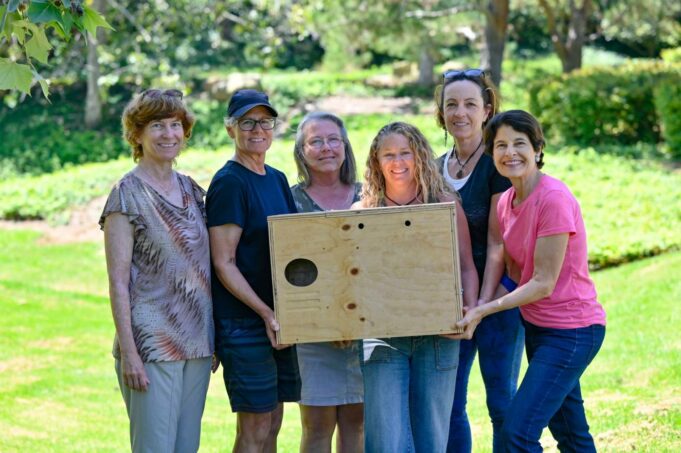Written by Brooke Staggs
They call themselves the HOOT Group. Four years ago, Irvine-resident Kim Huxman said, a growing number of residents in her University Hills neighborhood were reporting issues with rats chewing through car engine wiring and eating their backyard gardens. At the time, the nonprofit that manages the community, which houses UC Irvine faculty and staff, was handling their rat problem the way most housing communities and businesses still handle it — with poison.
But Huxman said it wasn’t working. Worries about the well-documented dangers that poisons pose to wildlife, pets and kids only increased. So did the rats.
Huxman had just seen “The Biggest Little Farm,” a documentary about a Moorpark couple who’d been able to manage pests without using rodenticides or pesticides. She thought, “if they can do it, we can do it,” and fired off an email to her community’s email chain to see if any more of University Hill’s 4,000 residents were interested in teaming up to explore alternatives for reducing their rat population.
“A whole bunch of people came out, and we’ve been together ever since,” Huxman said.
As she spoke, Huxman stood Monday with five fellow HOOT Group members beneath a homemade owl box they recently installed at a neighborhood park in hopes of luring a key predator to join their rat-fighting team. No owls have come home to roost yet, but the group’s hopes are high.
In recent years, as stories have spread about mountain lions and beloved family dogs dying with rat poison in their systems, a growing number of California communities have pushed to replace rodenticides with integrated pest management plans that incorporate everything from landscape changes to amenities like owl boxes that invite native predators. And the movements often are led by regular residents — like the people who make up the HOOT Group, which already has changed pest management practices in its neighborhood and inspired a nearby community to go poison-free.
A 12-foot tall barn owl box in the University Hills neighborhood of Irvine, CA, on Monday, August 29, 2022. The HOOT Group (Help Our Owls Thrive) designed the boxes to attract owls to help lower the rat population. (Photo by Jeff Gritchen, Orange County Register/SCNG)
Terry LePage, left, Linda Tacy, Kim Huxman, Patty Bartell, Sabrina LaRocca, and Sandrine Scherson, right, with a 12-foot tall barn owl box in the University Hills neighborhood of Irvine, CA, on Monday, August 29, 2022. The HOOT Group (Help Our Owls Thrive) designed the boxes to attract owls to help lower the rat population. (Photo by Jeff Gritchen, Orange County Register/SCNG)
A 12-foot tall barn owl box in the University Hills neighborhood of Irvine, CA, on Monday, August 29, 2022. The HOOT Group (Help Our Owls Thrive) designed the boxes to attract owls to help lower the rat population. (Photo by Jeff Gritchen, Orange County Register/SCNG)
A barn owl sits high in an oak tree at Irvine Regional Park in Orange in January 2021. Residents hope to attract more owls to nest in their neighborhoods to help naturally control the rat population. (Photo by Mark Rightmire, Orange County Register/SCNG)
A barn owl surveys the crowd moments before its release at the Orange County Bird of Prey Center in Trabuco Canyon on Saturday, October 12, 2019. Raptors such as owls are being called on to help control the local rat population. (Photo by Mark Rightmire, Orange County Register/SCNG)
“We just want to make people aware that you can’t just put poison out and expect a problem to be solved,” Huxman said. “It doesn’t solve any problem. We need to look at it in a systematic way.”
Poisons remain popular
Start to pay attention, and you’ll likely spot lots of little black boxes at strategic locations in community parks and greenbelts, or along the walls of homes and businesses.
The boxes contain bait packed with various forms of rodenticides. Rats and mice take the bait and can die more than a week later. Some boxes containing nerve toxins, some contain toxic doses of vitamins, and others deliver anticoagulants that cause rats to internally bleed to death.
Controlling rat and mice populations is important. Not only can the pests damage property by chewing through plastic pipes and burrowing into insulation, they also can carry life-threatening diseases such as Hantavirus along with plague-infested fleas. Then there’s the anxiety that can come from the sound of rats gnawing on the walls or running through the attic.
But rats that eat poison are easy prey for other wildlife, Huxman noted. Both pets and scavenger birds and mammals — from owls and hawks to racoons, foxes, skunks, coyotes, bobcats and mountain lions — can also hemorrhage to death after eating dead or dying rodents that have taken poisoned bait. Or, non-rats can die by eating the bait itself if it isn’t well protected.
“I don’t really mind rats,” said Linda Tacy when asked about why she joined HOOT Group, which stands for Help Our Owls Thrive. “But I had a dog. And rats would eat the poison and then crawl into my backyard and die. … I didn’t want (my dog) to get secondarily poisoned.”
Even kids can be victims. The Environmental Protection Agency reported that, during a four-year study through 2003, they found 25,549 children under 6 had symptoms of poisoning after being exposed to rodenticides.
Potent poisons known as second-generation anticoagulants pose the biggest risks. So, in 2014, the state banned consumers from buying those products, though it allowed for the continued use of those poisons by licensed pest control companies. But four years later, the state reported second-generation anticoagulants still were showing up in 90% of tested mountain lions, 88% of tested bobcats, 85% of tested Pacific fishers and 70% of tested northern spotted owls. And between the summer of 2018 and spring of 2019, the deaths of four Southern California mountain lions were linked to rat poison.
As those stories made the news , the city of Laguna Beach voted in spring of 2020 to ban all anticoagulants . Since that summer, Laguna Beach and its contractors have used a rodenticide called bromethalin, which is a nerve toxin, at city parks and facilities, according to Reza Jafari, the city’s deputy director of Public Works.
“We have not observed any problems since switching over two years ago,” Jafari said. “And we feel these products are working well.”
In fall 2020, California passed Assembly Bill 1788 . With exceptions for some medical and food production facilities, the law permanently banned the use of second-generation anticoagulants in wildlife settings and temporarily banned their commercial use everywhere else while the Department of Pesticide Regulation studies the impacts of those products. That study is still underway, the department confirmed Tuesday, Aug. 30, with no estimate for when it might wrap up.
While activists such as Huxman applaud these steps, they don’t feel the bans go far enough, citing data that shows first-generation anticoagulants and other toxic rodenticides still pose threats to wildlife and kids. So HOOT Group’s goal — modeled after influential groups such as Poison Free Malibu and Berkeley-based Raptors are the Solution , or RATS — is to make their communities completely rodenticide free.
Alternatives abound
Standing in Irvine’s Vista Bonita Park, HOOT Group member Sandrine Scherson pointed at the thick ivy and other non-native plants that cover the carefully manicured hillsides and parkways.
“This is the worst kind of vegetation,” Scherson said. The thick ground cover attracts snails, which rats love to eat, and offers rats a perfect place to hide.
Huxman said clearing such groundcover and thick vegetation is one way that communities can naturally help reduce their rodent populations.
Keeping trash and debris, such as wood piles, clear and covered is another way to stave off infestations. That’s why, though Huxman supports new state laws that encourage composting, she discourages open compost pits that can attract pests.
Another way to control the rodent population is to introduce raptors — nature’s pest control managers — to the neighborhood. In 2014, amid Malibu’s push to ban rodenticides, Pepperdine University phased out use of rat poisons. A key was installing raptor perches throughout campus. The perches gave owls and hawks, which populate the Santa Monica Mountains, easy spots from which they could eye their prey.
That’s also where owl boxes come in.
Barn owls don’t make nests, and instead use the cavities of trees, buildings or cliffs — or manmade boxes — to raise their young. A family of barn owls will eat about 1,000 rodents a year, foraging up to three miles from their homes each night to catch rats and other problematic animals, such as gophers.
After getting approval from their neighbors and local sustainability committee, HOOT Group got help from their property manager, Irvine Campus Housing Authority, to install four owl boxes made by two members’ husbands. Each wooden box is mounted on a pole 10 to 15 feet high, with a hole just large enough for a barn owl to enter and a second “room” that can be used for nesting.
Earlier this year, the team enlisted local raptor expert Peter Bloom for advice on where to place the boxes. Bloom said shady spots attract owls. So far, no owls have set up shop, a process that can take two to three mating seasons.
The group learned one important lesson, after bees took over one of the proposed owl boxes. Luckily, Huxman said, a bee expert was able to relocate the hive and sell the honey at a community event. Now they’re experimenting with ways to keep future bees away, such as lining the ceilings of the owl boxes with felt.
All of these strategies are long-term fixes, HOOT Group members acknowledged. In the meantime, they’ve been able to convince their property manager to replace half of the 400 poison bait stations in University Hills with enclosed snap traps. They hope to reach 75% in 2023 and be at 100% snap traps by 2024.
When Stuart Beveridge, a board member for the nearby Canyon’s Edge homeowners association, heard about the effort to phase out rodenticides he helped lead the charge to swap all poison stations in his community for baited snap-traps. And while residents can still use rodenticides in their own homes, Beveridge said his HOA has requested that they reconsider other poison-free methods as well.
Beveridge’s group then approached Irvine Ranch Water District and the city about ways to encourage rat predators in the area, since there’s less risk to them from poisoning.
Now, Irvine, which already has six owl boxes up in its parks, is looking to install raptor perches in the nearby open space area, according to city spokeswoman Kristina Perrigoue. And Irvine Ranch Water District plans to install an owl nesting box in the area next week, according to Ian Swift, the water district’s manager of Natural Resources.
Such efforts do require a bit more upfront cost and manpower than tossing out poison stations, Swift said. But over time, he and others said the research shows pest control costs should go down, with less damage and maintenance needed once integrated plans take root.
Seeing the ripple effects of what they started is encouraging for HOOT Group members, even if their own community still has a ways to go to be rodenticide-free.
“It’s been a long process,” member Terry LaPage said. But they’re getting there, one owl box and snap-trap at a time.
Shared from OC Register











